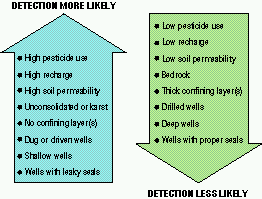National Water-Quality Assessment (NAWQA) Project
Go to:
Much effort has been directed toward evaluating the many natural and human factors that govern the transport and fate of pesticides in soil and ground water (see Figure 7). However, the nature of many of these influences is not yet well understood because of the difficulty of sorting out the confounding effects of numerous variables. Extensive research indicates that, in addition to reducing use, the most effective ways to reduce the likelihood of ground-water contamination by pesticides are to minimize the rate of water movement through the soil, especially following pesticide application; and to slow the rate at which the active ingredients are released to the soil. Efforts to minimize water movement affect not only irrigation techniques, but the timing of pesticide applications and the manner in which the soil is tilled. Field studies have shown that, other factors being equal, pesticides have a greater potential to move to ground water under "no-till" conditions than under conventional tillage, even though the effects of tillage on water and pesticide movement may be seasonal.
